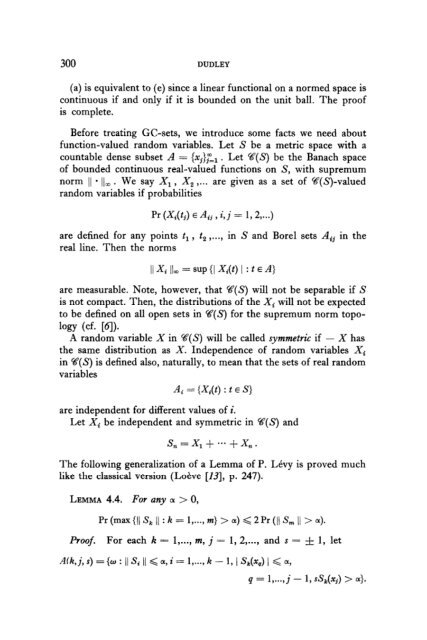On the Characters and the Plancherel Formula of Nilpotent Groups ...
On the Characters and the Plancherel Formula of Nilpotent Groups ...
On the Characters and the Plancherel Formula of Nilpotent Groups ...
You also want an ePaper? Increase the reach of your titles
YUMPU automatically turns print PDFs into web optimized ePapers that Google loves.
300 DUDLEY<br />
(a) is equivalent to (e) since a linear functional on a normed space is<br />
continuous if <strong>and</strong> only if it is bounded on <strong>the</strong> unit ball. The pro<strong>of</strong><br />
is complete.<br />
Before treating GC-sets, we introduce some facts we need about<br />
function-valued r<strong>and</strong>om variables. Let S be a metric space with a<br />
countable dense subset A = {+‘ZZ1 . Let %(S) be <strong>the</strong> Banach space<br />
<strong>of</strong> bounded continuous real-valued functions on S, with supremum<br />
norm II * IL . We say Xi, X, ,... are given as a set <strong>of</strong> V(S)-valued<br />
r<strong>and</strong>om variables if probabilities<br />
Pr (Xi(ti) E Aij , i, j = 1, 2 ,...)<br />
are defined for any points t, , t, ,..., in S <strong>and</strong> Bore1 sets A, in <strong>the</strong><br />
real line. Then <strong>the</strong> norms<br />
II Xi I/m = SUP {I xi(t) I : t E A)<br />
are measurable. Note, however, that W(S) will not be separable if S<br />
is not compact. Then, <strong>the</strong> distributions <strong>of</strong> <strong>the</strong> Xi will not be expected<br />
to be defined on all open sets in V(S) for <strong>the</strong> supremum norm topo-<br />
lo!3 (cf. PI).<br />
A r<strong>and</strong>om variable X in V(S) will be called symmetric if - X has<br />
<strong>the</strong> same distribution as X. Independence <strong>of</strong> r<strong>and</strong>om variables Xi<br />
in q(S) is defined also, naturally, to mean that <strong>the</strong> sets <strong>of</strong> real r<strong>and</strong>om<br />
variables<br />
Ai = {Xi(t) : t E S}<br />
are independent for different values <strong>of</strong> i.<br />
Let X, be independent <strong>and</strong> symmetric in %‘(S) <strong>and</strong><br />
The following generalization <strong>of</strong> a Lemma <strong>of</strong> P. Levy is proved much<br />
like <strong>the</strong> classical version (Loeve [23], p. 247).<br />
LEMMA 4.4. For any LY > 0,<br />
Pr (max {\I S, 11 : k = l,..., 4 > 4 < 2 Pr (II S, II > 4.<br />
Pro<strong>of</strong>. For each k = l,..., m, j = 1, 2 ,..., <strong>and</strong> s = f 1, let<br />
Afk, j, s) = {w : )I Si 11 < a, i = l,..., k - 1, ) &(x0) 1 < OL,<br />
q = l,..., j - 1, sS,&) > a}.

















